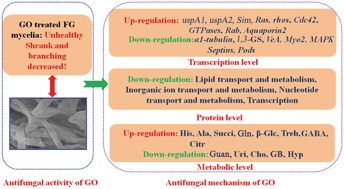Metabonomics-assisted label-free quantitative proteomic and transcriptomic analysis reveals novel insights into the antifungal effect of graphene oxide for controlling Fusarium graminearum†
Abstract
Graphene oxide (GO), which has been emerging as a novel antimicrobial agent against plant pathogens, has aroused great research interest and is considered as highly promising in agricultural science. However, to the best of our knowledge, the antifungal mode of GO remains largely unknown. Here, we systematically investigated the antifungal activity of GO against an important plant pathogenic fungus Fusarium graminearum (FG) strain PH-1 as well as the potential mechanism by integrating transcriptomic, proteomic and metabolic techniques. The antifungal activity of GO against FG strain PH-1 was found to be concentration-dependent. GO at 62.5, 125, 250 and 500 μg mL−1 significantly reduced the mycelial biomass and branching of FG strain PH-1. Transcriptomic analysis indicated that eight and nine genes were respectively down- and up-regulated by GO treatment in FG strain PH-1, which were involved in the mycelial growth, cell wall development and stress response. In addition, obvious protein responses were observed in FG strain PH-1 exposed to different concentrations of GO (62.5–500 μg mL−1). GO treatment enhanced the histidine metabolism and decreased the number of lipid proteins involved in cell wall synthesis, which could affect mycelial cell wall synthesis. Based on nuclear magnetic resonance, metabolomic analysis revealed that significant changes in metabolites mainly involved carbon and nitrogen flows, such as the TCA cycle, GABA bypass, and metabolism of amino acids, lipids, glucose, trehalose, succinate, citrate, GABA, glutamine, choline, hypoxanthine, guanosine and glycine betaine. GO treatment caused increases in the contents of glucose, succinate, citrate, GABA, glutamine and trehalose in FG strain PH-1, and also led to a significant decrease in lipids. The significant decrease in hypoxanthine and guanosine also indicated that GO treatment affects the DNA and RNA synthesis. In conclusion, this study not only provides a promising antifungal agent candidate for plant protection, but also facilitates an in-depth understanding of the interactions between fungi and GO.



 Please wait while we load your content...
Please wait while we load your content...